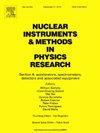γ射线谱仪GRETINA对高达6 MeV的高能γ射线的绝对效率响应
IF 1.4
3区 物理与天体物理
Q3 INSTRUMENTS & INSTRUMENTATION
Nuclear Instruments & Methods in Physics Research Section A-accelerators Spectrometers Detectors and Associated Equipment
Pub Date : 2025-07-22
DOI:10.1016/j.nima.2025.170858
引用次数: 0
摘要
GRETINA(伽玛射线能量跟踪束内核阵列)是一种最先进的γ射线跟踪光谱仪,在推进核结构研究方面发挥了重要作用,特别是在使用稀有同位素的快束实验中,在飞行中发射的γ射线受到大多普勒频移的影响。这项工作提出了一个实验确定的γ射线探测效率的GRETINA在能量高达6兆电子伏特。高能γ射线来源于中间束能量约为85兆电子伏特/核子的抛射束在核子去除反应中填充的状态。利用γ-γ巧合,在光束中提取效率值,并利用GEANT4蒙特卡罗模拟将其转换为静态源效率。前向定位探测器的效率存在系统性差异,这是由于在前向角度普遍存在的高能光粒子事件引起的特定死区时间效应,在Ge晶体中产生信号,使前置放大器的第一级饱和。该研究为束流内实验提供了精确的效率基准,提高了未来使用GRETINA和GRETA(伽马射线能量跟踪阵列)进行定量γ射线能谱分析的准确性。本文章由计算机程序翻译,如有差异,请以英文原文为准。
Absolute efficiency response of the γ-ray spectrometer GRETINA for high-energy γ rays up to 6 MeV
GRETINA (Gamma-Ray Energy Tracking In-beam Nuclear Array), a state-of-the-art -ray tracking spectrometer, has been instrumental in advancing nuclear structure studies, particularly in experiments using fast beams of rare isotopes where the rays emitted in flight are subject to large Doppler shifts. This work presents an experimental determination of the -ray detection efficiency of GRETINA at energies up to 6 MeV. The high-energy rays originated from states that were populated in nucleon-removal reactions from a projectile beam at an intermediate beam energy of about 85 MeV/nucleon. Utilizing - coincidences, efficiency values were extracted in-beam and translated into a source efficiency at rest employing GEANT4 Monte Carlo simulations. A systematic discrepancy in the efficiency of the forward-positioned detectors was identified which is attributed to specific dead-time effects caused by high-energy light-particle events prevalent at forward angles, generating signals in the Ge crystals that saturate the preamplifier’s first stage. This study provides refined efficiency benchmarks for in-beam experiments, improving the accuracy of quantitative -ray spectroscopy analyses with GRETINA and GRETA (Gamma Ray Energy Tracking Array) in the future.
求助全文
通过发布文献求助,成功后即可免费获取论文全文。
去求助
来源期刊
CiteScore
3.20
自引率
21.40%
发文量
787
审稿时长
1 months
期刊介绍:
Section A of Nuclear Instruments and Methods in Physics Research publishes papers on design, manufacturing and performance of scientific instruments with an emphasis on large scale facilities. This includes the development of particle accelerators, ion sources, beam transport systems and target arrangements as well as the use of secondary phenomena such as synchrotron radiation and free electron lasers. It also includes all types of instrumentation for the detection and spectrometry of radiations from high energy processes and nuclear decays, as well as instrumentation for experiments at nuclear reactors. Specialized electronics for nuclear and other types of spectrometry as well as computerization of measurements and control systems in this area also find their place in the A section.
Theoretical as well as experimental papers are accepted.

 求助内容:
求助内容: 应助结果提醒方式:
应助结果提醒方式:


